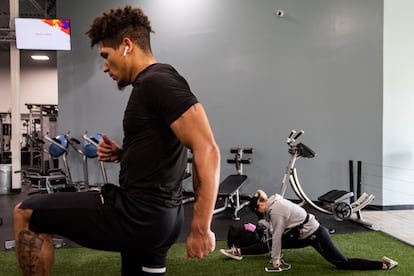Why sit-ups in the gym are a thing of the past
The classic abdominal exercise has lost popularity due to back problems it can cause. To get a six-pack now, there are safer exercises you can do, along with the support of diet and nutrition

For many years, counting sit-ups at a good pace or doing “as many as you can in two minutes”, has been part of the ritual to stay fit. Bend your back, squeeze your abdomen, raise your back. And repeat for as long as the body can stand. The more the better. This used to be the path to glory; glory that would one day arrive in the form of six well-marked tablets on the abdomen, also known as a six-pack. But not everyone could achieve this, no matter how much they suffered. As part of the liturgy, the most consecrated would measure their progress by tapping the critical abdominal zone.
Any curious observer, even someone who is not a regular gym-goer, will have noticed that these classic abdominal exercises have lost prestige and have gradually disappeared from training routines. The six-pack obsession is more alive than ever, but now it is achieved through other strategies, including diet and nutrition.
Sit-ups’ fall from grace in the mid-2000s became apparent in the very place they were created - in gyms in the US.
Its prestige was born in the 1940s, when the United States Army devoted itself to the training of its cadets. As part of their training, they had to complete as many sit-ups as possible in two minutes. This liturgy was not only considered a safe way to build physical strength, but also a reliable way to measure strength and other more subjective attributes such as character, dedication and sacrifice. To understand how sit-ups also invaded Physical Education classes in schools and then gyms, you need to first be aware that that fitness trends seek inspiration in military training regimes.
“With the classic crunches, the abdominal muscle is released as if it were the biceps: maximum contractions to achieve muscle hypertrophy and greater volume, but now it is known that if muscles are different, they should not be exercised in the same way”, reflects an independent personal trainer, Diego Jerez. “Now we know that the function of the rectus abdominis is not to generate movement, but to strengthen the spine and transmit force,” he adds.
1,000 sit-ups classes
If anyone is to blame for the decline in popularity of the classic sit-up, it would start with human anatomy scholars and biomechanics experts, who in around the 1980s began to question the idea that muscles could be trained separately, demonstrating that those in the abdominal area were connected to each other. It took a decade of research to confirm that the abs are just the most visible muscles in a network that works together, including the diaphragm, obliques, and pelvic floor muscles. This discovery also affected fitness jargon in the 21st century, and lead to talk of training the core, or all of the muscles of the central part of the body.
Andrés García Mazo set foot in a gym for the first time at the age of 15. “I remember that back then there were classes of 1,000 sit-ups. You don’t see that anymore. In the long term, so many repetitions take their toll on the spine and lower back because they are strained so much.”
Personal trainer John López also remembers those times. “Training is always about managing fatigue. When you’ve done 200 or 300 sit-ups, the quadratus lumborum (the deepest abdominal muscle) is injured by the sheer quantity of repetitions”.
“Perhaps if you work with a personal trainer, these exercises can still be effective, but only when the coach is in control of the technique,” says Andrés, who works as a coach of a variety of activities at the Metropolitan club in Madrid.
Both professionals have experienced how the classic sit-ups have been adapted or directly replaced by planks and other exercises that work to increase muscle strength. “These are exercises that are easier to understand and are more effective, there are no repetitions and injuries are minimized,” says Andrés García. “Now we train in a more effective way, prioritizing the strength of all muscles,” says John López. When the youngest coach at the Metropolitan club stared working, Adrián Medina, the 1,000 sit-ups obsession had long since moved into the world of bodybuilding exclusively. “We have to evolve, now we also know that to get the famous six-pack you have to follow very strict nutrition and diet rules. They are not achieved through contractions of the abdomen,” he says.
The back mechanic
The definitive death of the sit-up is attributed to Stuart McGuill, Canadian research expert in Biomechanics and professor at the University of Waterloo in Ontario. In 2015 he published the book ‘Back Mechanic’, his collated conclusions from 30 years of research. It is considered the most complete manual to prevent and cure back pain. After interviewing hundreds of people, he came to a compelling conclusion and recounted it in one of the chapters: Most people with chronic lower back pain had abused fast reps of sit-ups.
McGill explains in his book that when a person’s spine curves and tightens to move weight, that movement puts stress on their spinal discs. For this reason, workers who carry heavy loads often reach middle age with back pain. The only way to avoid it, says the professor, is to contract all the muscles in the center of the body - the famous core - to protect the spine and transfer the effort to larger muscles, such as those in the legs. This is exactly what weightlifters do, but it’s not the method that warehouse stockers always employ.
“The core is the center of the body, it is not only the abdomen, but also the gluteus and the long muscles of the back. It is a muscle group that must be contracted to give strength and protection to the spine. Our job now is to train it to contract automatically on a daily basis,” explains Diego Jerez, who also teaches Pilates. In his classes, he asks the students to maintain the natural curve of the lower back in order to prevent injury.
McGill demonstrated how sit-ups violate all of these principles. Lifting the full weight of your upper body from a resting position doesn’t allow you to strengthen your core or transfer weight to your legs. And exercise is repetitive by nature. “For generations, schoolchildren and troops alike were told to do as many sit-ups as possible in order to get a good grade on tests. Some people can do these exercises without any issues, but that ability depends largely on genetic factors, for example, how light or heavy the person is, not on skill. For military training and general population testing, sit-ups just don’t work,” he wrote in his book.
After the book’s publication, McGill began receiving hundreds of testimonials from people with injuries that matched the pattern he described. Most were trainers and physical therapists from the United States and the Canadian Armed Forces, who were the first to question the importance of sit-ups in their physical training regime. In the last decade, sit-ups have begun to be replaced by isometric and static exercises such as planks, and repetitive sets have been eliminated from mandatory tests. An Army and Marines spokesman confirmed to The Atlantic magazine that those changes were intended to reduce the numerous lower back injuries in troops who trained with repetitive sit-up sequences.
However, all of the professionals consulted for this report have had some experience with clients who continue to enjoy doing sit-ups and ask for them to be included in their training routines. If not, they assume they are not working hard enough. Six-packs are what the icons of physical health possess, so it’s difficult to topple them from the altar.
Tu suscripción se está usando en otro dispositivo
¿Quieres añadir otro usuario a tu suscripción?
Si continúas leyendo en este dispositivo, no se podrá leer en el otro.
FlechaTu suscripción se está usando en otro dispositivo y solo puedes acceder a EL PAÍS desde un dispositivo a la vez.
Si quieres compartir tu cuenta, cambia tu suscripción a la modalidad Premium, así podrás añadir otro usuario. Cada uno accederá con su propia cuenta de email, lo que os permitirá personalizar vuestra experiencia en EL PAÍS.
¿Tienes una suscripción de empresa? Accede aquí para contratar más cuentas.
En el caso de no saber quién está usando tu cuenta, te recomendamos cambiar tu contraseña aquí.
Si decides continuar compartiendo tu cuenta, este mensaje se mostrará en tu dispositivo y en el de la otra persona que está usando tu cuenta de forma indefinida, afectando a tu experiencia de lectura. Puedes consultar aquí los términos y condiciones de la suscripción digital.
More information
Últimas noticias
Alain Aspect, Nobel laureate in physics: ‘Einstein was so smart that he would have had to recognize quantum entanglement’
Imelda Castro, the woman who wants to rule the cartel battleground of Sinaloa
The new victims of the Republican war on Obamacare: Millions hit by soaring health insurance premiums
A country divided on migrant rights: Some US states expand protections while others restrict them
Most viewed
- David King, chemist: ‘There are scientists studying how to cool the planet; nobody should stop these experiments from happening’
- Reinhard Genzel, Nobel laureate in physics: ‘One-minute videos will never give you the truth’
- Oona Chaplin: ‘I told James Cameron that I was living in a treehouse and starting a permaculture project with a friend’
- Sinaloa Cartel war is taking its toll on Los Chapitos
- Mexico completes its trade shift with the entry into force of tariffs on China and countries without trade agreements











































